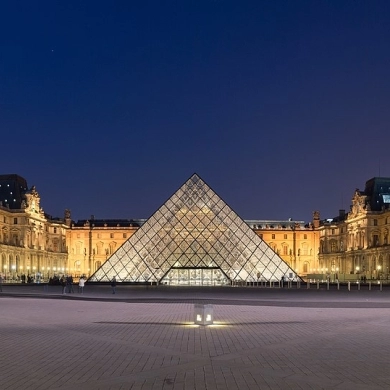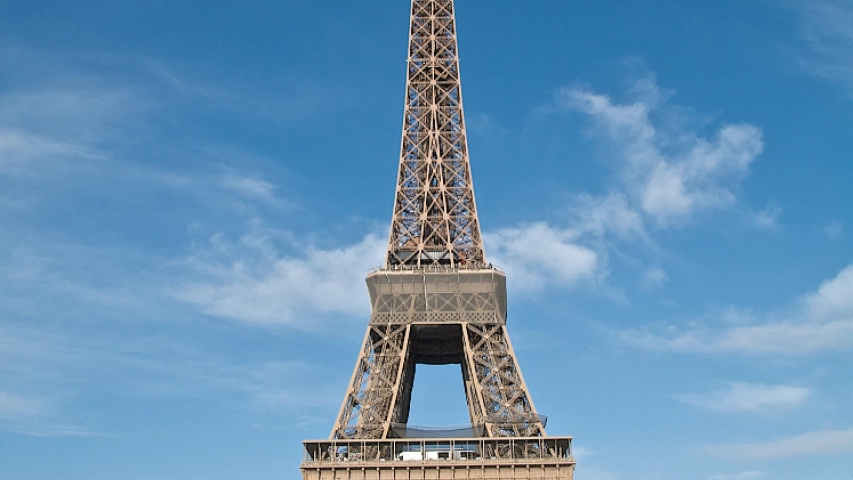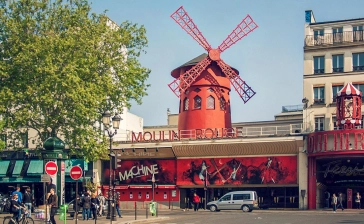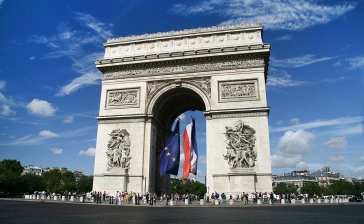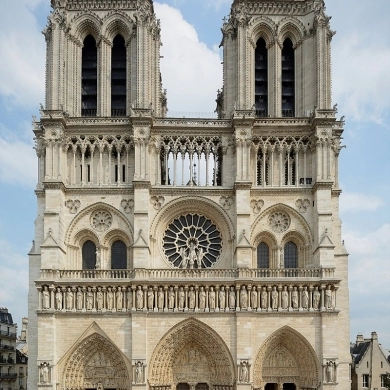Paris, also known as the "City of Light" or "Ville Lumière," is the capital and one of the most popular tourist destinations in France. It is located in the north of the country and is bisected by the Seine River. The oldest part of the city is believed to be the two islands of Ile Saint Louis and the island of Cité, with settlers dating back to around 250 and 200 B.C. The city is relatively flat with the highest point being Montmartre at 130 meters above sea level.
With a population of 2.5 million people and a metropolitan area of 12 million, Paris is the second most populous city in Europe after London. The 19th century saw Paris as a center for architectural development, with notable structures such as the Galerie des Machines and the Eiffel Tower built for the 1889 Paris Exhibition.
Paris is the most visited tourist destination in the world, with an estimated 42 million visitors annually. The city offers a wide range of experiences, from high-end fashion and dining to world-renowned cultural attractions such as the Eiffel Tower, Notre Dame Cathedral, Champs-Elysées Avenue, Arc de Triomphe, Garnier Opera, Louvre Museum, National Museum of Natural History, and the Museum d'Orsay.
Some important facts about Paris:
- Its currency is the euro
- The telephone prefix is (+33)
- The time zone is GTM + 1
- France is the most visited country in the world.
- Their favorite food is cheese, but they also love snails.
- Although Paris is known as the city of light, it rains an average of 110 days a year in this city.
- On July 14, the taking of the Bastille (the beginning of the French Revolution) is celebrated. This day a great military parade is celebrated in the capital.
Paris is a city that offers a wide range of experiences for visitors with reduced mobility. From adapted excursions, theme parks, to and restaurants, there is something for everyone to enjoy. Motion4rent.com provides important information and resources to help visitors with reduced mobility plan their trip, including information on accessible places of interest and tourist offices. Whether you are looking to explore the city's rich culture and history or simply relax and enjoy the sights and sounds of Paris, www.motion4rent.com is here to help make your stay as enjoyable as possible.
In Paris there are many information points, but we break down the most important and central offices.
Information point Place Hotel de Ville:
The Place Hotel de Ville Information Point is a valuable resource for visitors with reduced mobility to Paris. As one of the most central and important information points in the city, it is fully accessible and staffed with competent and multilingual agents who are ready to assist visitors with any information or assistance they may need.
The office offers a wide range of resources, including maps, free guides, and information on more than 500 hotels in the city. They can also help visitors plan their itinerary and provide recommendations for the best tourist attractions to visit in Paris.
Note that the office is closed on December 25th.
Accessibility Information
Reduced mobility:
- Access thanks to a lifting device.
- Door with automatic opening.
- Reception desk with low part.
- Display of specific brochures at the correct height,
- Rest seats. (For the reception of meetings, toilet adapted to the ground floor, access to the meeting rooms by elevator and with wide circulation).
Visual disability:
- Tactile map for visually impaired and blind people.
- Absence of obstacles at face height.
- Staff present to guide people.
- Audible announcement.
- Hearing impairment:
- Reception desk equipped with a magnetic induction circuit for people with hearing disabilities.
Mental disability:
- Responsive reception staff.
- Signage associated with simple pictograms at the level of brochure display.
Accessibility:
- Metro: Hotel de Ville stop (Line 1)
- Train: Chatelet – Les Halles stop (Line 4)
- Bus: lines 29, 38, 67, 69, 75, 76, 96
Address:
- 29 rue de Rivoli. District 4. 75004 Paris
Gare du Nord Information Point:
The Gare du Nord Information Point is a great resource for visitors arriving in Paris by train. Located between tracks 7 and 9 of the international arrivals area, the office offers a wide range of tourist information and assistance, including help with transportation and access to free maps and guides to help visitors navigate the city.
The multilingual staff are available to answer any questions you may have and provide recommendations to make your stay in Paris as enjoyable as possible.
Please note that the office is closed on December 25th, January 1st and May 1st.
Accessibility:
- RER commuter train: Gare du Nord lines B, D and E (We recommend checking the lines and stops that are accessible for people with reduced mobility)
- Metro: Gare du Nord lines 4 and 5 (Remember that only metro line 14 is accessible)
- Bus: numbers 32, 38 and 43 (all buses in Paris are accessible to people with reduced mobility)
Address:
- 18 Rue de Dunkirk Face aux voies 8-9, 75010 Paris, France
Carrousel du Louvre information point:
The Carrousel du Louvre Information Point is a valuable resource for visitors looking to explore the city and its famous Louvre museum. Located inside a shopping center next to the museum, the information point offers a wide range of services, including hotel reservations and transportation assistance.
The multilingual staff can also provide information and recommendations on other activities and attractions in the city. The shopping center is fully accessible to people with reduced mobility, including its own entrance to the Louvre museum. It also features 33 shops and 12 restaurants.
The shopping center and the information point are open from Wednesday to Monday from 10:00 a.m. to 7:00 p.m. (closed on Tuesdays).
The bathrooms are also accessible for people with reduced mobility.
Accessibility:
Metro:
The Carrousel du Louvre is connected by lines 1 (La Défense – Château de Vincennes) and 7 (La Courneuve – Mairie d'Ivry / Villejuif).
“Palais Royal – Louvre Museum” stop, “Carrousel du Louvre” exit.
These stops are not accessible to people with reduced mobility.
Bus:
The Carrousel du Louvre has lines 21, 27, 39, 48, 67, 68, 69, 72, 81, 95.
Stops: “Palais Royal – Musée du Louvre” or “Palais Royal – Comédie Française” or “Musée du Louvre”.
In this case, they are accessible for people with reduced mobility.
Private car:
The "Parc Carrousel Louvre" can be accessed via avenue du Général Lemonnier, 75001 Paris
- From rue de Rivoli: turn left at the traffic lights for Place des Pyramides
- From Quai des Tuileries: turn left at the traffic lights for Pont-Royal
- From Pont-Royal: go straight on, direction "Opéra", then keep to the right
In all three cases: enter the tunnel; At the traffic light located at the lowest point of the tunnel, take the central ramp marked "Parc Carrousel Louvre".
On foot or in a chair:
3 pedestrian accesses serve the Carrousel du Louvre:
- 99, rue de Rivoli 75001 Paris
- Departure from the Louvre Museum, place de la Pyramide Inversée
- 2 entrances from the Jardin des Tuileries, stairs on both sides of the Arc de Triomphe du Carrousel.
Address and contact:
- 99, rue de Rivoli, Paris 1st district
- Telephone (+33) 0143164710
The Paris Visite Pass is a convenient option for tourists visiting the city for a few days. The pass is available for 1, 2, 3, or 5 days and is valid for travel in different zones, depending on the option selected. The zones range from 1 to 3, which includes travel within Paris and the surrounding area, to zones 1 to 5, which includes travel within Paris, the nearby suburbs, to Orly and CDG airports, Disneyland, and Versailles.
How does it work?
The pass allows for unlimited travel on the metro, RER, Tramway, and bus lines in the Paris region, except for Fileo, tourist circuits, Air France buses and the Montmartre funicular.
Before use, you must write your name, surname and the dates of use on your magnetic ticket. Once identified, the magnetic ticket is personal and non-transferable.
Useful information:
- The price varies according to the option selected and the rates range from €14 for one person in the option of zones 1 to 3 and for one day to €73 for one person in the option of zones 1 to 5 and for 5 days.
- The pass is activated when you use it for the first time. Once you activate your pass, it will be valid for the remainder of that day and subsequent consecutive days. So if you activate a 3-day pass on a Monday, you'll have all of Monday, Tuesday, and Wednesday to use.
- Rates available for adults and children from 4 to 11 years old (10% management fees)
- Public transport is free for children under 4 years old.
- If your pass is demagnetized, the RATP workers can exchange it for a new one at any metro or RER station, and this is totally free.
- With this pass you will also have discounts on some of the city's attractions, such as a boat ride on the Seine, entrance to the Opera or the Tourist Bus.
Airports: Paris has 3 airports:
CHARLES DE GAULLE:
The main and most important is that of Charles de Gaulle. It is located about 25 km from Paris and is the second busiest in Europe, after Heathrow (London).
About to transport between the airport and the center of Paris, there are many options available and here we explain them:
Train:
- RER B suburban train, this train connects the airport with Paris and its outskirts. CDG station 1 serves terminals 1 and 3 while CDG station 2 serves terminals 2 A, C, D, E, F and G (terminal 2G is connected to 2F by the free link N2). The trip takes approximately 35 minutes.
Important: Access to the train is through a walkway, upon request (at least one day in advance) by phone or by mail to Accès Plus Transilien. Contact: telephone: (+33) 970824142 or email: accesplus@transilien-sncf.fr
- SNCF central line: the “Aeroport Charles de Gaulle 2 – TGV” station is accessible for people with reduced mobility and is located between terminals 2C-2D and 2E-2F. Terminals 2A, C, D, E, F are accessible via the carousel (10 minute away) or the free shuttle N1 (on the 5th floor). Terminal 2G is also connected to 2F via link N2. For terminals 1 and 3 take the free CDGVAL shuttle train.
- Station accessibility
- Presence of staff: Yes
- Assistance offered to access the platforms and get on/off the train: Yes
- Wheelchair available: Yes
- Surveillance strip on platforms: Yes
- Information screens at the station and/or on the platforms: Yes
- Audible information at the station and/or on the platforms: Yes
- Toilets: Yes
- Toilets adapted for wheelchair users: Yes
- Information accessibility or point of sale
- Access by elevator, ramp or on the same level, from the entrance: Yes
- Guidance system for people with visual disabilities from the entrance: Sound beacons and tactile guide strips
- Magnetic induction loop: Yes
- The CDGVAL shuttle train: allows you to move around the airport. In just 8 minutes it connects terminals 1, 2, 3 + the RER-TGV railway stations + the PR and PX remote car parks. The train leaves every 4 minutes in the period between 4 am and 1 am. It's free and you don't need a ticket. This service is 100% accessible for people with reduced mobility and you do not have to ask for any help.
Bus:
All buses are accessible for people with reduced mobility and all bus stops are at terminals 1, 2A-2C, 2D, 2E-2F.
- Line 2: This line takes you to the center of Paris (Etoile, Porte Maillot, Trocadéro, Eiffel Tower) and Paris Charles de Gaulle Airport. The trip takes about 45-60 minutes (70 to the Eiffel Tower).
- Line 3: This line connects CDG airport and Paris-Orly airport. Stops at Orly Airport are located on the arrivals floors at Gate L (South) and Gate D (West). The trip takes about 70-80 minutes.
- Line 4: This line connects the city center of Paris (Gare de Lyon and Gare Montparnasse) with CDG airport. The journey takes about 60-70 minutes.
Roissybus:
It is important to note that Roissybus is not included in the Paris Visite Pass, and a separate ticket must be purchased for the journey. The bus is equipped with a ramp for wheelchair access and has designated spaces for people with reduced mobility. The bus also has an audio-visual information system that announces the stops.
The journey time is about 60 minutes. Frequencies of passage vary from 15 to 30 minutes depending on the time of day.
Taxi:
Since March 2016, Paris taxis have charged a fixed price for the journey from Charles de Gaulle airport to the city center or vice versa, and the price includes luggage. The cost is typically 55-60 euros.
Not all airport taxis are accessible, but adapted taxis can be found among the fleet that is normally found at the airport.
At the airport, you will find taxis outside the baggage claim area of the following arrival terminals:
- Terminal 1: gate 24 on the Arrivals level
- Terminal 2A: gate 6
- Terminal 2C: gate 14
- Terminal 2D: gate 7
- Terminal 2E: gate 10 on the Arrivals level
- Terminal 2F: gate 11 on the Arrivals level
- Terminal 3: exit from the arrivals area
- Terminal 2G: blue door.
Rental car:
At Charles de Gaulle airport, various car rental companies are available, and all the major companies offer vehicles that are adapted for people with reduced mobility.
PARIS-ORLY
This airport was the main airport in Paris until Charles de Gaulle airport was built in 1974. It is smaller, and is located approximately 15 km south of the city. To travel from the airport to the center of Paris, there are several transport options:
Train:
- Commuter train “RER”: For this option, we will have to change at Antony, and we must ask for help to access the RER. We should also consider which stop in the city center we want to get off at and check if it is accessible. First, we must take the Orlyval train to Antony, then the RER B. Access to Orlyval is through gate K in the Sud terminal and gate A in the Ouest terminal. Upon arrival at Antony, go to the counter for the installation of the mobile access ramp to the RER.
ORLYBUS bus:
This bus provides connection between Paris-Place Denfert Rochereau (in front of the RER B station) and Paris-Orly airport (Sud and Ouest). The travel time is approximately 30 minutes. All buses are accessible for people with reduced mobility.
Line bus:
Another option is bus 183, this bus line connects the airport with the city and is accessible for people with reduced mobility. The journey time is between 40 and 50 minutes.
Taxi:
If traveling in a group or have mobility issues, this may be the most comfortable option to go from Orly to the center of Paris. It's important to remember that since 2016, the price of taxis from Paris airports to the city center is fixed, so there is no need to worry about being deceived. The price to the left bank of the Seine is 32 euros and to the right bank is 37 euros.
BEAUVAIS (BVA)
Beauvais (BVA) Airport is the smallest airport in Paris, located about 85 km from the city center, and mainly operated by the Ryanair company. For travelers with mobility issues, it is recommended to take the bus as a transfer option.
Train:
The SNCF provides a train that connects Beauvais city station with Paris. The journey takes approximately 1 hour and 15 minutes. However, this option is not recommended for travelers with mobility issues as they would have to take a taxi from the airport to the train station and then change trains in the city center to reach their final destination. The taxi fare from the airport to the train station is around 15 euros, in addition to the train fare.
Bus:
The official Paris-Beauvais-Tillé airport bus connects the airport with Paris (Paris Pershing Porte Maillot bus station). The journey takes 1 hour 15 minutes and the bus leaves 15-20 minutes after the plane lands, coordinating with the flight schedules. The vehicles are wheelchair accessible (manual or electric).
Taxi:
This is the most expensive option to go from Beauvais to Paris, since the price is around €170 each way with a day rate and €210 with a night rate.
The journey takes between 1 hour 00 min and 1 hour 30 min depending on the time and the point of departure or arrival in Paris.
Transportation within the city:
Commuter train “RER”:
The RER is a railway network that connects Paris and its surroundings. It has 5 lines: A, B, C, D and E. The RATP directs one part and the SNCF the other. This service opens at 06:00 in the morning and closes at 00:45 at night every day of the week.
Accessibility to stations is marked with 4 symbols depending on their level of accessibility:
- Blue circle: These stations are 100% accessible for people with reduced mobility as they have lifts and access ramps and can be accessed without the need for assistance.
- Yellow circle: These stations are accessible, but you must ask for help to access, at these stations there are warning buttons on the platforms, but you can also contact the station staff to request help.
- Telephone symbol inside a yellow circle: These stops are accessible, but you must notify them at least 24 hours in advance by contacting (+33) 970824142 or by mail at accesplus@transilien-sncf.fr and they may contact you. ask for the European card for people with disabilities.
- White circle: These stops are not accessible to people with reduced mobility.
- Line A connects the Disneyland® Paris parks
- Line B connects the Stade de France and Roissy-Charles de Gaulle airport
- Line C connects the Château de Versailles
- Line D also connects the Stade de France
- Line E connects the eastern outskirts of Paris.
In the capital, the main stations are Châtelet-Les-Halles (lines A, B and D), Invalides (line C), Gare du Nord-Magenta (lines B, D and E) and Gare de Lyon (lines A and D).
Rates apply according to zones (zone 1 to 5). Paris and its surrounding areas correspond to zones 1 and 2. The Château de Versailles is in zone 3, while Charles de Gaulle airport and the Disneyland Paris parks are in zone 5.
For more information, do not hesitate to visit the RATP and Transilien websites.
Metro:
The Paris metro is not the most suitable method of transport for people with reduced mobility, as most of its lines are not accessible for wheelchairs.
The metro network consists of 16 lines, with 300 stations marked by a large yellow letter "M." Lines 1-13 are not accessible for people with reduced mobility, but line 14 offers full accessibility with lifts and ramps, allowing for travel across the entire city.
All stations have sound information and rough markings on the ground for people with vision and hearing impairments. However, it's important to note that only manual wheelchairs can be comfortably used on the subway due to the distance between the platform and the train.
Bus:
Buses are the best option for moving around Paris, as all of them are accessible via retractable ramps, and the vast majority of stops (90%) have good access (those that do not have it are marked with a yellow triangle).
There are 64 bus lines that connect almost all points of the city. Buses have a designated space for wheelchairs and sound information for people with vision problems.
Touristic bus:
In Paris, there are several tourist bus companies that offer hop-on and hop-off service at the city's most important tourist spots. While not the cheapest option, these buses offer comfort, fun, and an audio guide.
Among the companies available, we recommend Big Bus as a third of its fleet is adapted for people with reduced mobility. Of the routes offered, we recommend the red route as it runs through the best-known and most emblematic areas of the city.
Tram:
In Paris there are 4 tram lines and lines T1, T2 and T3 are accessible to people with reduced mobility thanks to their level access.
Taxi:
In Paris, there are several taxi companies that offer vehicles adapted for transporting people in wheelchairs, one of them is G7 Access. These taxis are available 24/7 and have the same rates as regular taxis.
G7 Access company has 120 vehicles adapted for people with reduced mobility and their drivers are trained to assist passengers with disabilities at all times. You can contact them by phone: (+33) 141276699 or (+33) 147390091.
The fares for taxis are regulated, and it's based on customer service, the price per kilometer traveled and the price per hour, with surcharges and supplements. For trips to certain airports, the amount is fixed, and an invoice must be given to the customer as soon as the amount of the trip reaches a certain amount.
One of the things you cannot miss if you visit Paris is a boat trip along the Seine and we suggest a company that provides this service for people with reduced mobility.
This company is located in Pont de L'alma very close to the Eiffel Tower, their boats have been recently renovated, are accessible and have glass, in addition to having audio guides in many languages they also have staff who will help you and explain everything you want to know about the route and the buildings and monuments that we will see during the tour.
The tour lasts approximately 1.5 hours.
- Hours from April to September: It leaves every 30 minutes and from 10:00 in the morning until 22:30 at night.
- Hours October to March: It leaves every 40 minutes and from 11:00 in the morning until 21:20 at night.
Le Chalet du 8è, www.lechaletduhuitieme.com
This restaurant located next to the prestigious avenue des Champs Elysées, the Chalet du 8e, in addition to being accessible, is very original since the place has the style of a mountain chalet, but in the heart of Paris. The house specialty: crepes and galettes (savory pancake made with buckwheat flour), accompanied by tasty salads. The dishes are copious and the atmosphere is cozy.
The restaurant is accessible to people with reduced mobility and its bathrooms are too.
Accessibility:
- Metro: Saint Philippe du Roule stop (This stop is not accessible for PMR)
- Bus: Lines 28, 32, 52 and 80
- Address and contact:
- 8 rue du Commandant Rivière. 75008 Paris
- Telephone (+33) 0145611810
Restaurant the Alcazar, www.alcazar.fr
The Alcazar restaurant is accessible for people with reduced mobility, it is an English-inspired brewery with a lot of floral decoration inside and an impressive glass dome.
It has two floors where you can taste traditional French food, but also foreign... If you can, we recommend that you attend on a Sunday at lunchtime since its menu is well known and appreciated by its most loyal customers.
The restaurant is accessible and so are its bathrooms.
Accessibility:
- Metro: Odéon stop
- Train: Saint Michel or Notre Dame stops
- Bus: Lines 58, 63, 70, 86, 87 and 96
Meriggio Restaurant: www.meriggio-paris.com
This Italian restaurant is accessible to people with reduced mobility.
This restaurant works with small producers of La Botte, raw and cooked artisan products that are not yet found in the capital and all this in a warm and pleasant place to visit at any time.
This restaurant is closed on Sundays.
- Address and contact:
- 3 rue Rougemont 75009 Paris
- Telephone: (+33) 0148241508
- Mail: meriggioparis@gmail.com
Riccete Restaurant: www.ricetteristorante.com
This accessible restaurant for people with reduced mobility offers the classics of la botte but also new creations. It is a very cozy place where home cooking is practiced made up of fresh and seasonal products, it is based on Italian food, more specifically Sicilian.
It has gluten-free dishes and every week there is a vegan suggestion on its menu.
In addition this restaurant is also a place for art exhibitions.
Accessibility:
- Train: RER B
- Metro: Lines 10 and 7
- Bus: Lines 38, 47, 63 and 86
- Address and contact:
- 10 rue du Cardinal Lemoine 75005 Paris
- Telephone: (+33) 143265212
- Email: cardinal.ricette@gmail.com
